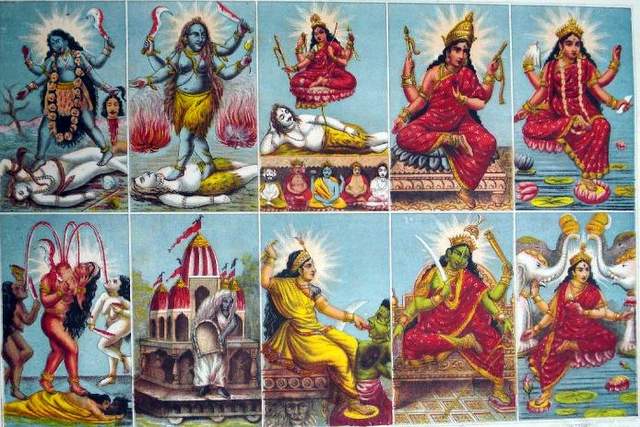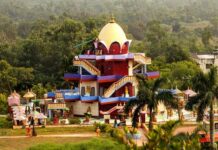Kamakhya is the primary Shakti Peetha of Bharatvarsha, the Yonipeetha where Devi Sati’s Yoni had fallen, making it the seat of creation. I have already written in detail about the Kamakhya temple and its festivals.
This time in Guwahati, I wanted to visit all the Dash Mahavidya temples located on Nilanchal Hill. It took me a few hours and a small auto rickshaw ride to visit all the temples.
Who are Dash Mahavidya Devis?
Dash or 10 Mahavidyas are the 10 manifestations of Adi Para Shakti. Their story comes in Mahabhagwat Purana. Sati wanted to visit her father Daksha at Kankhal, and Shiva wanted to stop her. He knew that if she went, he would never meet her again in the same form. She was adamant and manifested 10 forms in all 10 directions to stop Shiva from stopping her. These 10 swaroops or manifestations came to be revered individually as well as collectively as Dash Mahavidyas.

Come with me to these Dash Mahavidya Temples as I experienced them:
Sodashi, Matangi and Kamlatmika – 3 of Dash Mahavidya
The main Kamakhya temple garbhagriha itself contains the three Mahavidyas:
- Sodashi or Rajrajeshwari Lalita Tripursundari is Kamakhya herself, who is the third among the Mahavidyas after Kali and Tara. She is the Adhishtatri Devi of this place, it is her Peetha or the seat. She is the presiding deity of this kshetra. She is one responsible for creating, nurturing and dissolving this world.
- Matangi – the ninth Mahavidya, also considered a form of Saraswati who bestows the powers of expression through speech and performing arts
- Kamalatmika – the tenth Mahavidya, a form of Mahalakshmi often depicted as Gajalakshmi being showered by elephants.
The three can be seen or rather experienced inside the garbhagriha. The best way to reach them is to buy a VIP ticket and get into the queue to visit the garbhagriha. Incidentally, there is no Murti of Ma Kamakhya inside the sanctum, she is in the form of flowing water.

You do an anthropomorphic form of her right outside the garbhagriha, where most pujas are done. It is a beautiful Murti, adorned with all kinds of flowers and the form simply comes alive in front of you.
On your way to the garbhagriha, you can see the different Murtis carved on the temple walls.
Dhumavati and Bhairavi Mahavidya
After visiting the three Mahavidyas, we were back in the open courtyard of Kamakhya temples. From here the priest pointed us to the back gate to visit Ma Dhumavati and Ma Bhairavi.
We passed through a narrow lane to reach a staircase. After going down a few steps, we first saw the Dhumavati temple. It has clearly undergone a recent renovation with dark granite stone shining through. We stepped in and were led to the garbhagriha where all I could see was an open pit with a bright pink cloth shining from one side of it. It took our eyes some time to adjust when we realized that it was an underground source of water. The flowers we saw on the right of the pink cloth are actually floating in the water.
We bent down and touched the water, wishing for its healing powers and asking Ma Dhumavati for her blessings. She is the one who takes away all your misfortune in the form of poverty of any kind. After spending some silent moments here, we stepped out.

Vantage Point
From this vantage point, we could see the Ma Bhairavi temple. It is a steep flight of stairs going down to the temple. You see what is left of vegetation on the hill. Along with the temple you see a large temple tank. I started walking down and was wondering how will I climb back all these stairs, given my health. Just then, a few devotees climbing back told us not to go down as the temple is closed. They advised her to pray from where we were standing. I took it as a sign and said my prayers to Bhairavi or Tripura Bhairavi, and sought her permission to visit other temples. The temple courtyard was indeed empty and I wondered if Devi was choosing to be alone.
We were back in the Kamakhya temple premises where our Panda ji guided us to the three temples that can be visited right outside the main gate of the temple.
Kali, Tara and Chhinmasta Mahavidyas
We walked out through the main gate. It was around 10 AM and the markets leading to the temple were in their full glory. In the morning, when we took the same path around 6 AM, there were only a few flowers and prasad shops. Now, you can see the arts and crafts of Assam in full glory, tempting you to take them back with you.
We first saw the lovely arch in blue with two lions clinging to it, with a flight of stairs leading to Tara Mandir. We climbed and found ourselves in front of the pale pink temple in a typical Assamese style, somewhat resembling the Chala style of Bengal. It is a small but powerful temple. We stepped inside and bowed down to Devi who is OM personified and bestows the power of speech.
Kali Temple
Coming back to the road, we walked just a bit to see the Kali temple, right there. It is a temple that is now surrounded by a road on one side and buildings on the other side. The small garbhagriha again has a depression where Ma Kali is wrapped in a bright red cloth. Is this too a water channel, I could not see. Being the first Mahavidya, she is the ruler of Kala or time. If you are enjoying good times, thank her, and if you are going through a bad time, pray to her. She is the one who transports you across eras and eons.
Read More – Kali Temples of Kolkata
Back on the road, a little ahead as the road turned right, we saw another large temple, this is the abode of Ma Chhinmasta – the one who holds her own severed head in her hands. Her temple is simple in off-white with red borders, a reminder of the power of simplicity. The Garbhagriha is a level below where you must go down a steep flight of stairs and it is pitch dark. Again, all I could see was a red and golden chunari with flowers on it. This temple too has a water channel inside the garbhagriha that devotees touch and apply to their heads and eyes. There are many other temples in this temple complex but Chhinmasta is the primary deity here, the one who takes you beyond the mind.
Bhuvaneshwari and Baglamukhi Mahavidya
Ma Bhuvaneshwari is the one who rules the spaces, all the 14 Bhuvanas in the universe. Her temple is located on top of a hill a little away from the main Kamakhya temple. Early morning, it would be a good trek to do, but during the day, it is best approached by an auto. This is a beautiful temple in yellow overlooking the Brahmaputra. Spread across a large area, you reach the temple via easy stairs. Inside, there is a huge hall, where many people were doing their silent sadhana. Outside there is ample space for you to sit or walk around.
You get a lovely view of the city of Guwahati from here. It has the mighty Brahmaputra on one side and lush green hills on the other and the city in between nature and nurture.

From here we started our back downwards and stopped at Ma Baglamukhi temple. You can not miss the yellow shops all around the road leading to it. Yes, yellow is the color of Ma Baglamukhi who gives the power of Stambhan or stillness when everything stops. We went down a flight of stairs to reach the temple.
We stepped inside a large hall with a huge rock on one side in a way that it formed the wall of the hall. A few priests were getting Puja done close to this rock, as the devotees said their prayers with folded hands. The water dripped slowly from this wall. A board pointed to the main temple next door.
Vulva shaped rock
We stepped into the next room, and I was awestruck to see a vulva-shaped rock with water dripping from it. Everything around this was yellow. The priest allows you to step ahead and take a bit of water as prasad or a blessing of Ma Baglamukhi. This part of the rock is the continuation of the rock in the first room. At some point in time, it must have been just the rock and the temple must have been built much later. Of all the Dash Mahavidya temples, here you see the Yoni Peetha most clearly.
I prayed to Ma Baglamukhi to protect me from enemies, both inside and outside me. The energy of this temple would stay with me for a long time.
In no time, we were back at the bustling bazaar outside the Kamakhya temple. We thanked Panda ji for all his help in telling us about the temple and guiding us for all Dash Mahavidya temples.

I had a satisfying ride back to my hotel in Guwahati. It was a long pending desire to see all the 10 temples at this powerful Shaktipeetha. It was Devi Kripa that allowed me to see all of them so beautifully.
Travel Tips for Dash Mahavidya Temples in Guwahati
Except the main temple, all other temples are nearly empty. You can visit them easily and spend as much time as you like there.
Buy a VIP ticket at Kamakhya that costs Rs 501/- at the time of writing, which allows you to have fast darshan. The general queue may take a very long time. Read more on the temple website.
You can take your mobile phone inside the temple but photography is not allowed inside any temple.
There is food and water available everywhere around the temples.
You can pick up books on Tantra at bookshops here.
Stay anywhere in Guwahati to visit Kamakhya temple.














Such a well-detailed exploration of the Dash Mahavidya Temple at Kamakhya! The spiritual depth and unique energy of this Shakti Peetha truly make it a must-visit destination for seekers and travelers alike. We’re always inspired by culturally rich locations like this, and we love helping travelers plan affordable and meaningful journeys to places just like Kamakhya. Thanks for shedding light on the history and significance—definitely bookmarking this for our readers!
Thank you for this beautifully detailed and deeply insightful exploration of the Dash Mahavidya temples at Kamakhya! Your vivid descriptions and personal experiences truly bring to life the spiritual richness and unique energy of each deity and temple. I especially appreciate the way you highlight the connection between the water elements and the divine feminine power, offering a fresh perspective beyond the usual temple narratives. This post is a valuable guide for anyone seeking a meaningful pilgrimage or spiritual journey in Guwahati—grateful for your careful research and heartfelt sharing!